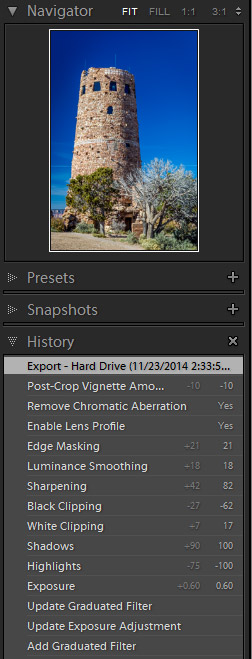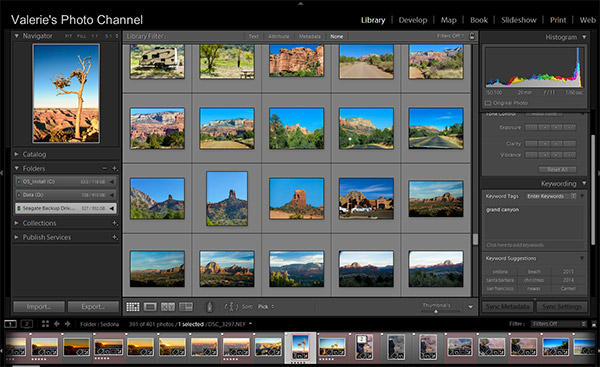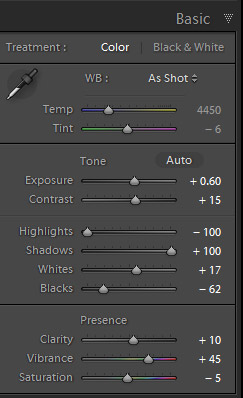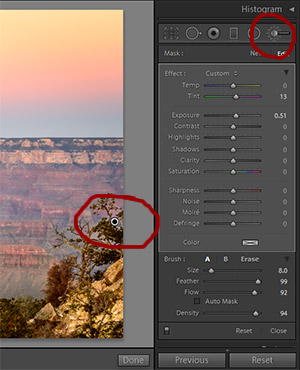Why I love Lightroom for Image Processing and Organizing
There are dozens of sites that offer reviews of Adobe Photoshop Lightroom, so in this post I'm going to tell you why it's my favorite tool for organizing and processing my digital photos. While Photoshop is awesome, I find that at least 90% of the time I never need to go into Photoshop to edit or retouch my images, I can do everything in Lightroom.
Nondestructive Editing
 If you're new to Lightroom, it works a bit differently than other software like Photoshop, Photoshop Elements, Corel Paintshop Pro and other traditional image editing programs. Lightroom is catalog based, which means any changes you make to an image are recorded as data to the catalog and your original image is never touched. All the adjustments you make are stored as data, not as pixel changes as with Photoshop or other pixel-based software. I love this, because this means it's non-destructive editing. I can never accidentally overwrite an image and I can always get back to the original, untouched version if I want to.
If you're new to Lightroom, it works a bit differently than other software like Photoshop, Photoshop Elements, Corel Paintshop Pro and other traditional image editing programs. Lightroom is catalog based, which means any changes you make to an image are recorded as data to the catalog and your original image is never touched. All the adjustments you make are stored as data, not as pixel changes as with Photoshop or other pixel-based software. I love this, because this means it's non-destructive editing. I can never accidentally overwrite an image and I can always get back to the original, untouched version if I want to.
Unlimited Undos
This is something else I love. You get unlimited undos. In fact, using the history panel I can go back to any stage in the editing process, at any time. Unlike in Photoshop, where you lose the history that's stored in the buffer when you close the program, the full history of your image in Lightroom is always available, a day, a month, a year later because it's stored in the catalog as data. If you make 500 or 1000 adjustments and want to go back to the 50th, or the 2nd, you can.
You can also create virtual copies of an image, which is stored as data, and experiment with different effects, and still have your original.
Easy, Logical Workflow
So what can you do in Lightroom? The software is composed of seven modules: Library, Develop, Map, Book, Slideshow, Print, and Web and you can easily moe from one to the next.. The ones you will use most often will be the Library and Develop Modules.
Powerful Image Management System
Library is where you import, organize, manage, keyword and rate your images. Lightroom has powerful image management capabilities. The catalog works by creating a link or an association to your image wherever it's physically located on your hard drive, you aren't actually "importing" or moving images.

Collections
This is a great organizing tool in the Library. You can create collections of images; they are virtual, you're not actually moving them around and you can have the same image in multiple collections at the same time. This is a great feature that really makes organizing easy. Collections are the way to go, you don't need to touch your folders.
Virtual Copies
Want to experiment? You can make a virtual copy of your image and try out different things and still have your original to compare it to. The copy is stored as data so it's not taking up a lot of additional space on your hard drive.
Sharing
From the Library you can post images to social media and photo sharing sites like Facebook and Flickr. Online comments and Likes about your images are can be seen within Lightroom. I think a lot of people don't realize you can do this.
Easy Adjustments
 The Develop Module is where you make adjustments to your photos. Lightroom is designed for processing raw files, though you can also edit and enhance jpegs. Pictured at left is the Basics Panel, where you make tone and white balance as well as Clarity and Saturation adjustments sinply by moving the sliders. Cool, huh?
The Develop Module is where you make adjustments to your photos. Lightroom is designed for processing raw files, though you can also edit and enhance jpegs. Pictured at left is the Basics Panel, where you make tone and white balance as well as Clarity and Saturation adjustments sinply by moving the sliders. Cool, huh?
New in Lightroom 6 is the capability of processing HDR and panorama images right in the Develop Module, instead of having to go over to Photoshop. That's a really big improvement and a time-saver.
Incidentally, that's a cool thing you can do: jump over to Photoshop. Although you can do most processing and retouching inside Lightroom, there are occasions where you still need to do something in Photoshop, such as a composite image on layers, or to change the background or complex retouching. You can get to Photoshop from inside Lightroom, make your adjustments, save the image and it opens back up in Lightroom (as a tiff or psd file).
Local Adjustments
 You can use local adjustment tools like the Adjustment Brush, Radial Filter or Graduated Filter to make area-specific adjustments. For example, you can use a Graduated Filter to make the sky bluer or with the local adjustment brush soften wrinkles, or create special lighting or color effects in certain areas. The Cloning and Spot Removal Brush will fix blemishes and under eye circles, remove a garbage can or other unwanted object.
You can use local adjustment tools like the Adjustment Brush, Radial Filter or Graduated Filter to make area-specific adjustments. For example, you can use a Graduated Filter to make the sky bluer or with the local adjustment brush soften wrinkles, or create special lighting or color effects in certain areas. The Cloning and Spot Removal Brush will fix blemishes and under eye circles, remove a garbage can or other unwanted object.
Other Modules
The Map Module offers location based organizing via geo-tagging. If your camera is GPS-enabled, you can locate and group images by location and assign locations to images.
Make a Photo Book - you get photo book creation and printing via Adobe’s partnership with Blurb. You can design your own layout or use the Auto layout. You can either upload them to Blurb for printing or export as JPEGS to another photo site.
In Slideshow you can create presentations, set cover images and captions and add music.
Print gives you options for printing your images on your own printer or adjusting settings to export them for printing online. Soft proofing lets you preview how an image will look when printed. It changes the image background to white and shows colors based on the output device.
Web lets you create HTML or Flash web photo galleries to upload.
It's Easier Than Photoshop
I don't want to make this a comparison of Lightroom vs Photoshop, but a real advantage of Lightroom is that it's much easier to learn. That's not to say it's a simple program, it's not. But making tonal changes, white balance adjustments, sharpening and other adjustments is pretty easy, you just adjust sliders left or right and see the changes as you move them.
As I said, while it's not as difficult to learn as Photoshop, it's important that you learn to do things the right way from the start. I've got a series of free video tutorials here that will help you get familiar with the Library and Develop modules and tools.
Speed Up with Presets
You can also apply Presets to your images, either on import or during the later in the Develop stage. This can be a real time saver. You can also create print, naming and project presets.
Buying Standalone Software vs. Creative Cloud Subscription Program
There are two ways you can purchase Lightroom: either as standalone software where you are getting the version you buy, i.e. Lightroom 5 or 6, or you can consider getting the Adobe Creative Cloud Photography package which gives you Photoshop CC as well, on a monthly subscription basis for $10/month. I have this plan and I like it because the latest upgrades are included, so I will always have the most current version, plus, I do use Photoshop as well. Whereas if you buy the standalone download or boxed version of Lightroom 5 and want to get version 6, you will have to pay for the upgrade and any other future upgrades. But the choice is yours, and so far Adobe plans to continue to offer the standalone software for those who don't want a subscription plan.
New System Requirements
Going along with the HDR, Panorama and other new features, Lightroom 6 requires increased system requirements. You must be running Windows 7 or 8 or 8.1 or Mac OS 10.8 or higher and you need a 64-bit processor. Adobe says it's for added functionality including advanced imaging features and improved performance.
| Tweet | ||

 Hi. I'm Valerie Goettsch. There are so many fun things we can do with our digital photos. Here you'll get personal reviews and photography tips to make your photos shine. Follow me on...
Hi. I'm Valerie Goettsch. There are so many fun things we can do with our digital photos. Here you'll get personal reviews and photography tips to make your photos shine. Follow me on...
